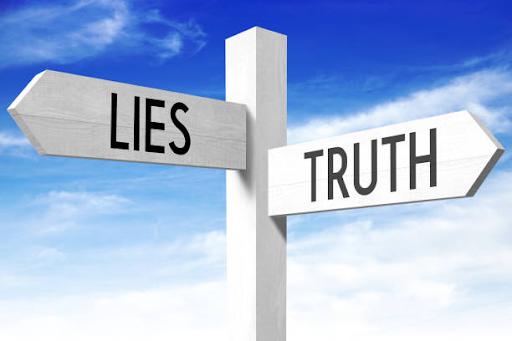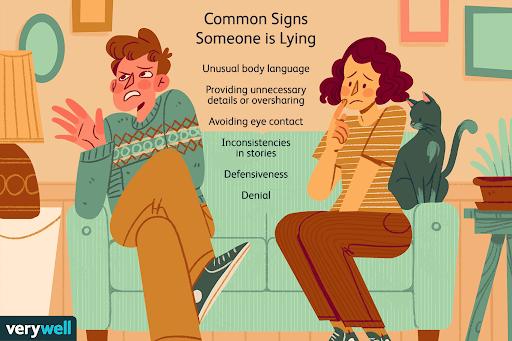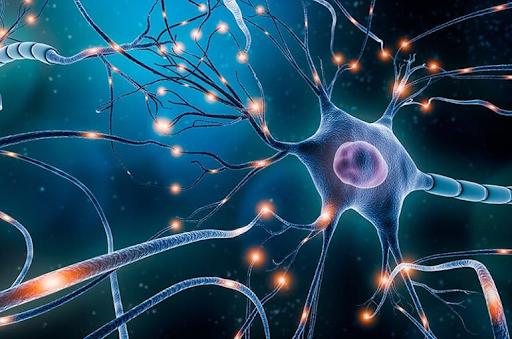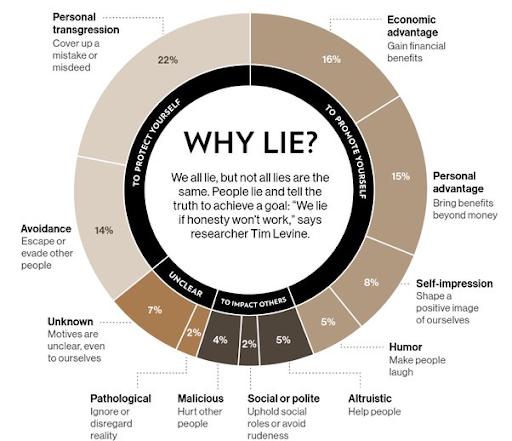Deception is like a maze, intricately designed with half-truths and lies that challenge our understanding of morality. It is often labeled as simply immoral, but it is a much more complex skill - a psychological chess game played with different motives. This process becomes an integral part of the human experience.
Navigating through Deception

Deception is a complex tactic, but within it lies darkness - deception: a powerful mixture of trust and deception. When such an opportunity arises in any situation, deception makes the art of deception the ultimate test of faith. It has the ability to break trust, ruin relationships and more. The latter is a complex emotional process unique to each person, ranging from guilt and regret to broken trust and damaged relationships.
Although it is quite harmful, many people still use deceit and deception to emphasize their influence and nuances of human nature. The motives behind their actions continue to be questioned, forcing us to learn more about necessity and destruction. Is cheating a necessary evil to help us survive? Or is it a destructive thought that leads to broken links?
It is important to consider the many points where deception and betrayal intersect with human nature. Each question brings us closer to the hidden truth. The art of deception is like a complicated road, where every turn leads to new complications.
How to Catch a Liar

Being around liars isn’t necessarily beneficial. In some instances, lying can be considered somewhat moral. For example, if you delay a truth that may hurt your friend by lying, there is an intersection between deception and the generosity of human nature. Here are ways you can catch a liar:
- Inconsistencies: Look for inconsistencies in the person’s words. If something seems out of place or illogical, it could be a sign of dishonesty. For example, if a person says they heard a gunshot but doesn’t turn to see the event, it shows inconsistency with a typical response to such a situation.
- Ask Unexpected Questions: When you ask someone a question that they aren’t prepared to answer, it can mess up their thought process and cause tem to say the wrong thing, revealing dishonesty. Although some people are accomplished liars, most people can be caught easily with this tactic.
- Gauge Against a Baseline: Changes in behavior are often signs of dishonesty. It can be helpful to observe how someone acts when they’re telling the truth and compare it to their current behavior. If there are drastic changes, they may be lying.
- Look for Insincere Emotions: Some people may display emotions that don’t seem genuine.
- Body Language: Liars will often be very fidgety and try to make themselves look smaller by pulling their bodies inward. This squirmish behavior is due to the fact that they are trying to hide the truth. They may also be very clueless, which causes a lot of shoulder shrugging.
- Micro-Facial Expressions: You can often tell if a person is lying because of their facial expressions, but some expressions may be harder to spot because of their subtlety. Some people may blush, flare their nostrils, bite their lips, sweat, and/or blink quickly. Such changes represent increases in brain activity.
- Tone, Cadence, and Sentence Structures: A person may speak quicker, slower, or with a different tone when they are lying.
- Baseline Speech Patterns: Deviations from typical speech patterns such as pace, pitch, and syntax, and word choice may be signs of deception.
- Avoiding Eye Contact: Avoiding eye contact doesn’t always signal deception, but some people find it hard to look at you straight in the eyes when lying. It’s important to make sure that this isn’t a result of cultural differences or variations in behavior.
- Contradictions in Verbal and Non-Verbal Cues: If a person’s body language doesn’t match with their verbal cues, it could be a red flag.
- Unusual Response Time: A liar may take longer to respond because they may be formulating the proper response in their head, so it is important to make note of delays in responses.
- Defensive Behavior: Signs of defensiveness such as crossing arms, avoiding questions, and/or becoming hostile may be shown when being accused.
- Story Details: While honest people tend to be consistent with their level of detail, liars may be too vague and overcompensate with unnecessary details.
- Changes in Grooming or Appearance: Drastic changes in grooming habits or appearance could be linked to deception because they signify stress, but it’s important to not make a judgment solely based on this.
- Polygraph or Lie Detector Tests: Polygraphs are not 100% accurate, but these tests can measure physiological changes associated with lying, such as changes in heart rate and skin conductivity.
- Repeat Questions: If there are inconsistencies in responses to the same question asked multiple times in different ways, it could indicate dishonesty.
What Happens when Someone Lies in their Body

When someone lies, many different physiological and behavioral changes can be observed. These signs don’t always guarantee an indication of lying because they can be influenced by other factors like stress and anxiety, and every person has individuality when it comes to the ability of hiding such indicators. Some common indicators of lying include:
- Increased Heart Rate: Lying can trigger the body’s “fight or flight” response
- Changes in Breathing: An increase in breathing rate or shortness of breath may occur when someone is lying. On the other hand, some people might hold their breath and lower their breathing rate.
- Body Language: Body language doesn’t always indicate deception, but non-verbal cues are indicators that should be looked out for.
- Facial Expressions: Deeply seated feelings can be revealed through minute variations in facial expressions.
- Speech Patterns: Inconsistencies in speech such as hesitating stammering or altering tone pitch or speed can be signs of deception.
- Gestures: Body language can be consciously or unconsciously controlled by the person resulting in odd or inconsistent gestures.
- Sweating: A physical reaction to the stress of lying may be increased sweating particularly on the forehead or palms of the hands.
- Defensiveness: When confronted with questions liars may act evasive or defensive in an effort to deflect the conversation away from the main subject.
What Happens when Someone Lies in their Mind (general)

Lying can cause many different interferences within the brain. It can lead to cognitive load, increased stress, anxiety, difficulty in memory, repression of emotions, internal conflicts, and so much more:
- Cognitive Load: Fabricating a tale or omitting accurate information are common components of lying. Because people must monitor misleading information and ensure consistency this increased cognitive load may cause mental strain.
- Increased Stress and Anxiety: Lying can cause tension and anxiety because of the worry about being discovered or the moral dilemma that comes with lying. An elevated heart rate, sweaty palms, or tense actions are examples of how this emotional reaction can show up physiologically.
- Memory Challenges: It can be difficult to keep track of a made-up story which could result in details being inconsistent. When confronted with follow-up questions or over time a liar may find it difficult to recall the made-up details and remain coherent.
- Decision-Making Processes: Choosing to lie requires a person to weigh the possible repercussions of speaking the truth against the advantages of lying that they believe will come from lying. Weighing potential risks and ethical considerations can be a part of this cognitive process.
- Emotional Regulation: To lie effectively and seem credible one must frequently control one’s emotions. In order to do this one may have to repress real feelings and exhibit fake ones that fit the invented story.
- Risk Assessment: Lying people may constantly evaluate their chance of being discovered. The continuous assessment may increase the person’s stress levels and have an impact on their behavior and communication.
- Internal Conflict: Lying can lead to guilt and internal conflict. A person may feel uncomfortable emotionally even if they are successful in tricking others because of their dishonesty.
- Adaptation to Deceptive Behavior: Over time, lying repeatedly can cause a person’s thoughts and actions to shift. Or on the other hand they might get more skilled at lying or feel more psychologically and cognitively disoriented.
What Happens when Someone Lies in their Neurons (science)

Being a consistent liar also affects the brain at a molecular level – the neurons. It affects (but is not limited to) the prefrontal cortex, the anterior cingulate cortex, the amygdala, the hippocampus, the rudimentary ganglia, the mirror neurons, and the dereliction mode network:
- Prefrontal Cortex (PFC): The prefrontal cortex, particularly the dorsolateral prefrontal cortex (DLPFC), is intertwined in deception. This region is associated with administrative functions, including decision- timber, planning, and inhibitory control. When someone lies, they frequently need to suppress veracious information and spark deceptive responses, engaging the DLPFC.
- Anterior Cingulate Cortex (ACC): The anterior cingulate cortex is involved in monitoring and detecting conflicts. When a person lies, there may be a conflict between the verity and the false information being presented. The ACC may play a part in managing this conflict and conforming behavior consequently.
- Amygdala: The amygdala is associated with processing feelings, and it can be involved in the emotional aspects of deception. When lying, individualities may witness increased emotional thrill, and the amygdala may contribute to the regulation of these emotional responses.
- Hippocampus: The hippocampus is pivotal for memory conformation and reclamation. When lying, individualities need to induce and maintain a harmonious narrative. The hippocampus is involved in the encoding and reclamation of information, and its exertion may be told during deceptive behavior .
- Rudimentary Ganglia: The rudimentary ganglia play a part in motor control and literacy. When someone lies, there may be subtle motor changes or differences in behavior. The rudimentary ganglia may be involved in these aspects of deceptive behavior.
- Mirror Neurons: Mirror neurons are a type of neuron that activates both when an individual performs an action and when they observe someone additional perform the same action. These neurons may play a part in empathy and social understanding. When lying, individualities may need to manage their behavior to appear satisfying, and glass neurons might be involved in this process.
- Dereliction Mode Network (DMN): The DMN is a network of brain regions active when the mind is at rest or engaged in tone - referential studies. During deception, individualities may need to cover their own studies and acclimate their narrative. The DMN may play a part in these tone - referential processes.
What Causes People to Lie

Social Skills and Survival Mechanism:
- Adaptation to Social Morals: Lying can be a learned behavior as individualities acclimatize to social morals and prospects. In some situations, people may lie to conform to societal or group norms. Survival Instinct: Evolutionary psychologists propose that deception may have evolved as a survival medium. individualities who could deceive others might gain advantages in terms of coffers, protection, or social standing.
Cognitive Development:
- Understanding of Truth and Falsehood: Lying often emerges as a cognitive skill during childhood as individuals develop a better understanding of truth and falsehood. Children may initially lie as a way to test boundaries or avoid punishment.
Emotional Regulation:
- Avoiding Consequences: People grant others permission to lie to prevent negative results, penalty, or public condemnation. Fear of consequences can lead people to conceal the truth.
- Maintaining Social Harmony: Deception can promote friendly cohesion and avoid conflicts or ruptured connections. People often resort to telling white lies to protect the dignity of others or to prevent any potential discomfort.
Coping Mechanism:
- Defense Mechanism: Lying can serve as a defensive strategy to safeguard one’s emotional well-being. People resort to falsehoods in order to avoid embarrassment, shame, or the realization of losing something valuable.
- Dealing with Stress: Stressful situations often lead to the adoption of defensive behaviors. The inclination to portray a more constructive or controlled perspective can sometimes result in deception.
Social Influence and Pressure:
- Peer Pressure: Social influences can be a catalyst for dishonesty. People may resort to lying in order to conform to a particular group, seek validation, or circumvent the risk of social exclusion.
- Cultural Expectations: Cultural elements have an impact on the development of attitudes towards truthfulness and falsehood. Societal norms can affect how often lying occurs and how socially acceptable it is.
Neurological Factors:
- Brain Development: The growth and maturity of specific areas in the brain, such as the prefrontal cortex, are connected to cognitive control and decision-making. Laying may be correlated with the capacity to suppress honest responses and handle contradictory information.
- Neurotransmitters: Neurotransmitters play a significant role in shaping impulsive behavior and risk-taking, potentially impacting the inclination towards dishonesty. Changes in the levels of neurotransmitters, such as serotonin and dopamine, can have an effect on these behaviors.
Personality Traits:
- Individual Differences: Individual variations in personality traits, such as extroversion, agreeableness, and conscientiousness, can have an impact on an individual’s tendency to deceive. To illustrate, individuals who possess a high level of agreeableness as a personality trait may be more inclined to engage in the act of telling harmless lies in order to preserve social cohesion.

